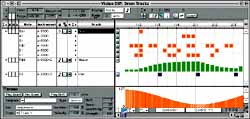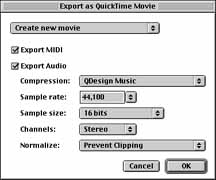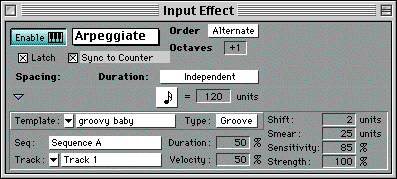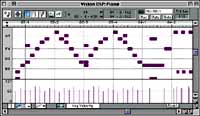FUTURE STYLE
|
OPCODE STUDIO VISION 4.5.1  Integrated MIDI sequencing and digital audio recording software for Macintosh Features include Power Mac native code, full support for Digidesign TDM bussing, advanced DSP features, enhanced integration with Apple's QuickTime and support for all major audio file types. Included are grooves in audio and MIDI format and other enhancement utitlities. While SVP 4.5.1 has TDM support and will support most Digidesign products, it will not interface with Digidesign 001. Platform System Requirements Minimum Install (MIDI only) Macintosh 68030 or higher (fat binary app works on 68k and PPC) MacOS 7.6.1 or higher (MacOS 8.5 is OK) 640x480 monitor w/ 256 colors or grays CD-ROM drive (floppy drive needed for authorization) 10 MB hard disk space for application install 8 MB RAM application space (no virtual memory) MIDI instrument and interface Recomended for audio PowerPC equipped Mac with Level2 cache or higher (604 or higher recommended) SCSI hard drive (most new Macs have IDE, so it may need to be external). 16 MB RAM minimum application space (>16MB preferred). 5 MB disk space per minute mono for audio recording/editing. ASIO compliant or Digidesign audio card recommended (but not required). Audio Hardware Compatibility ASIO Compatible Hardware Digidesign: (DAE, Nubus and PCI) ProTools 24 ProTools III and all compatible TDM plug-ins ProTools Project Session 8 Sound Tools II ProTools 442 AudioMedia II/III Yamaha Support for CBX will not be in the initial release of SVP but will be added back in with the 1 update. CBX-D3 CBX-D5 (with updated ROMs from Yamaha) Key Features Supports VST compatible real time effects. 4 DSP plugin Inserts available per console strip. EQ Edit window with graphic representation of EQ curve. Support for ASIO compatible sound cards. 8-24 bit support in DSP and playback. Displays CPU, RAM and Hard Disk performance graphically. More intuitive design. All preferences combined into one window called "settings". Template files for saving settings externally. Saveable Templates for VST banks and programs from within effect edit window. EQ available on each audio console strip Multitrack, multinote step editor makes adding notes to a rhythmic grid easy. New tool- Magic Drumstick for mass inserting or deleting of notes. New built in arpeggiator that uses new playback quantize for rhythm. Toggle to display strip chart in Track Overview or Pulse Editwindow. User choosable textures forwindows and dialogs. Map key equivalents for everything including DSP and Premiere functions. . Features enhancements Consoles Supports VST compatible real time effects. Console strip input now configurable from MIDI, Audio Instruments, Inputs, Outputs and Busses 4 DSP plugin Inserts available per console strip. Full Bussing feature available, 16 Busses in total Optional Mini Gain faders are available on each console strip for certain EQ types EQ Edit window with graphic representation of EQ curve. Saveable Templates for VST banks and programs from within effect edit window. Configurable Master Fader. 4 Aux sends available for each strip. EQ available on each audio console strip On/OFF and EQ Edit window open buttons are optional Preference to view instrument colors on console fader. Smart overdub so consoles or controllers can be recorded without destroying note data. Audio Enhancements Support for ASIO compatiblesound cards. Recording from anywhere in the audio chain directly. Adds support for VSTcompatible real time effects Adds new items to DSP menu (Pitch Shift, Formant Shift, Time Scale, Adjust Audio Tempo) Allows naming of Audio Instruments, Inputs, Outputs and Busses Select Unused - allows selection of all unused audio events in file. 8-24 bit support in DSP and playback. Stereo file support in all DSP including Premiere styleplug-ins.  Ability to import/export new QuickTime 3.0 types. Improved zooming and expanded waveform for tight edits. DSP processes on selected audio. Crossfades Auto naming of files option toimprove speed. New Crossfades dialog withmaximum control. Performance Monitor Window Displays CPU, RAM and Hard Disk performance graphically. Open button on Control Bar will display info without Performance Window being open.  Pulse Edit Window Multitrack, multinote step editormakes adding notes to a rhythmic grid easy. Columns can be hidden, resized or reordered. View multiple instruments in onewindow. Each line is a specifc note number (view can be set to only show lines with data). Set playback quantize individually for each track. Quantize can be set to groove or grid. User adjustable grid size. Velocities can be shown by height in grid. Velocities can be edited by dragging top of note. Can edit all selected note dataat once. New tool- Magic Drumstick for mass inserting or deleting of notes. Input Effects New built in arpeggiator that uses new playback quantize for rhythm. Both effects can be synced to sequence counter.  Arpeggiator features Up, Down, Random, Alternate and Latchmodes. All effects are recordable intoVision DSP Repeat input extended to follow playback quantize. Or, effects can be run withoutsequence playing. Strip Chart in Track Overview Toggle to display strip chart in Track Overview or Pulse Edit window. All edits apply to selected tracks. New Compression tool to scale values between upper and lower limit. Continuous controller oscillating tools for creating gating sweeps. Zoom in into specific areas for fine edits. Growable / resizeable windows. Legato changes- extend releases into next attack or shorten notes for zero overlap. Select and Modify More intuitive design. Includes Transpose, Quantize, Move Events, Modify Events, Set Instrument, Substitute, Reassign and Delete Now includes audio in selection criteria. Ability to edit by any command available in Strip Chart. Works across all data in sequences, segments and tracks. Command to Batch assign faders to controller and vise-versa. Now a window instead of a dialog so it can be open at all times. Settings can be saved as a Template. Drum Map transpose "Add To" button to easily create harmonies and echoes. Transpose redesigned for greater flexability and power General Enhancements User choosable textures for windows and dialogs. Reworded and redesign of all dialog features for clearer, easier use. Redesign of all windows and dialogs. New resizable large counter window with ability to choose font, size and display. All preferences combined into one window called "settings". Cursors move ahead on paste for faste repeat pasting. Help buttons in dialogs. Template files for saving settings externally.  Ability to overwrite controller data without losing notes. Bar limit increased to 9999 from 999. Finer Tempo resolution control. Quantize Enhancements Playback quantize to any value including grooves. Ability to quantize controllers. Quantize on input to any value. Grooves can be pasted and copied within any file. New templates for remembering settings. Improved user interface. Quantize individual tracks. Segments Sequence window redesignedwith moveable columns. Loops can be rounded to the nearest bar or set to start/end at any point. Top level sequences can be referenced and edited directly Mute both MIDI and Audio events. Create and name Segments from a simple dialog. Editing segment will edit all instances that reference it. Loops can be graphically resized and set. Double clicking on segment will open up default edit window instead of Track Overview. Choose number of repeats. Key Equivalents Map key equivalents for everything including DSP and Premiere functions. Command-arrow keys nudge pitch (up/down) and attacks in time (left/right). Redesigned window for MIDI keys. Pitch can be nudged by semitone, scale degree, map or octave. A key command to cycle around the cursor tools in each window. Time can be nudged by units, metrically or SMPTE. A select next tool command. Nudge settings are user definable. Opcode Systems, Inc. - 309 Plus Park Blvd. - Nashville, TN 37217, Usa info |
advanced technologic sound magazine 2003 april issue 114
|
